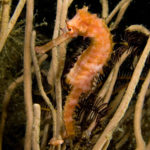On May 4th a colleague of mine, Dr. Brian Sidlauskas, curator for the fish collection of Oregon State University, received this email.
Respected Prdf. Brian;
On most humanitarian ground, would you please be so kind to provide me 25 Preserved MYXINE /EPTATRETUS sps. ;Hag-fish; Size Range 10″-15″ ,7 Petromyzon marinus ,and 15 Sub-Adult of HYDROLAGUS colliei for anatomical study use and these fishes would also be beneficial to the present and future generations for the generic and families representation and taxonomic studies at our Museum ?
These fishes are endemic to your Region and are easily collectable.
Our students will get an opportunity to learn more about these fishes. Please Preserve your fishes in 5 % Formalin for 7 days and finally keep them in 45 % Ethanol for additional 2 days to reduce formalin
These Preserved Fishes are NOT included in the Negative list NOR in CITES. These Fishes are frequently importable into India under “Open General License: 2.1 and CTH # 16042000” as per Current Import-Export Policy of India.
Please take an active Part in Indian Educational System and help our Indian students to the best of your ability ON COURTESY.
You may send these Dead/ Preserved(Damp-Packed) Fishes via EMS SPEED-POST PARCEL OR through Freight-Paid FED-EX (International : Economy)Shipment.
Hopefully, I am looking forward to have your sincere co-operation in the near future. Please reply soon.Thanks.
Dr. S. T. Rehmani
Director
Museum of Life-Science
Institute of Higher Education
 Museums and university collections typically lend specimens to researchers for a variety of reasons. An informal request with a discussion of the specific need is usually sent to the curator first to establish contact. Once the curator and researcher discuss needs and feasibility, a specific loan request is made. Alternatively, requests can be made of common and abundant species specifically for teaching collections, i.e. specimens to be viewed but no dissected. If you are alumni of a college course in biological sciences, you have likely seen specimens donated by a museum. Overall such requests are common practice and for Brian to receive such an email is not unusual.
Museums and university collections typically lend specimens to researchers for a variety of reasons. An informal request with a discussion of the specific need is usually sent to the curator first to establish contact. Once the curator and researcher discuss needs and feasibility, a specific loan request is made. Alternatively, requests can be made of common and abundant species specifically for teaching collections, i.e. specimens to be viewed but no dissected. If you are alumni of a college course in biological sciences, you have likely seen specimens donated by a museum. Overall such requests are common practice and for Brian to receive such an email is not unusual.
However, Brian noted something odd about the request. The email does not read like a typical specimen request. For example, the request was very specific about the desired size of the specimens without providing any justification as to why. The requested sizes are similar those used in dissections in a course lab. However, specimens loaned from museums are not typically used for dissection. Instead, the earthworms, frogs, and of course fish needed for courses are ordered from biological supply companies. Brian also noted that a fairly large number of specimens were requested. Finally, the types of fishes requested are commonly used in comparative anatomy classes around the world. But most importantly, Brian nor his colleagues had ever heard of the institution requesting the gift of specimens.
Of course, anyone who has read a the-wealthy-but-hiding-prince-who-can-access-his fortune-in-a-Nigerian-bank email can also recognize the email as kind of ‘spammy’.
Indeed, other museum curators received very similar requests going back nearly two decades. Mike Retzer at the Illinois Natural History Survey and Andy Bentley at the Natural History Museum at the University of Kansas both received similar inquiries requesting fish specimens in 2008. Richard Rosenblatt, a Professor Emeritus at Scripps Institution of Oceanography, recalled getting requests nearly 20 years ago from Rehmani. The emaisl asking for specimens were also received at the American Museum of Natural History, National Museum of Natural History, Milwaukee Public Museum, Field Museum, Florida Museum of Natural History, and the University of Colorado Museum. Request like them by Rehmani can also be found across the internet including this one to a pet store and one to the Chinese Sturgeon Museum.
In 2002 the tactic and requesting person were different but the corresponding address was the same. This time there was a fire and instead of Dr. Rehmani there was Dr. Haq.
In his messages was a sad story (burnt museum and all collections, needed to establish new collections, asked for help)… Many times he promised to send back some common Indian animals in exchange, but he never answered or in best case told that he hadn’t get any shipment.
An excerpt from the Rehmani/Haq’s email read
As you know that our entire Herpetological and Ichthyological laboratories and its systematic collections have completely been destroyed in a disastrous fire event of 1994 and we have to bear a great loss of 2307 preserved specimens from 38 countries of the world which were displayed in our galleries. Under these circumstances, I hereby request for your sympathetical co-operation of preserved specimens.
The first email Bentley read from Rehmani/Haq told of the tragedy of lost collection due to a fire. Bentley happily donated samples in response, as did others, with the only contingency being a trade of common species from India in exchange.
However, after specimens were sent, Rehmani/Haq replied these specimens never arrived and requested more.
Thanks for your fax dated October 11, 2001. To – date, your Air-mail Parcel of september 5,2001 has not been arrived here, I had asked you to let me know the Air-Post Parcel Number (Refer the postal receipt. It would be mentioned on the postal receipt of your parcel). By fax or on our E-mail address, please provide the following information to me to enable me to contact the Foreign Post Office, New Delhi, India to enquire the fate of your parcel.
Thanking you, Sir,
With best regards, Respectfully yours,
Dr. Mohammad F. Haq
When Bentley began following asking for more specifics, the email exchange went dead.
Often Rehmani/Haq met denials of specimens with indignation as exemplified by this online request to the Chinese Sturgeon Museum.
One museum collection manager noted,
Because we were in the process of preparing for a move, I told him that we could not attend to the request yet, but that we would do our best to help him out after the dust settled. He ended up sending me numerous letters that I found rather harassing.
Andy Bentley, smelling something worse than poorly preserved fish, decided to pursue the truth.
First there are two aliases–Dr. Rehman and Dr. Haq. Both claimed to work at the Life Sciences Museum in Jhansi. No such institution exists. Bentley confirmed this both with Indian scientists and colleagues (email below). The former actually visited the address. The colleague, not observing any signage, talked to people in the area. To their astonishment it was discovered the “museum” was actually a biological supply company.
Yesterday I got full details about Dr.Haq. You are right .In Jhansi there is no LIFE SCIENCE MUSEUM. There is only one museum which is under State government and it is related to history. Dr.Haq is not associated with this museum. According to my friends from Jhansi, Dr.Haq is having export business and he supplies or sells the museum materials to India and abroad at very high rates. In Jhansi he is having no good reputation and Everyone knows about his fraud work. I am really shocked .I request you to send this e-mail to everyone related to this so called museum owner.
Regards
[Named Removed]
Multiple emails to Dr. Rehmani and Haq by Bentley confirming their status as a museum have never been met with a reply. More troubling is petitions from Bentley to the various officials in the Indian government for further investigation of the Museum of Life Science have fallen on deaf ears.
Our request at DSN is for more information from Jhansi (with photos) that can provide further evidence, and emails exchanges between U.S. curators and Rehmani/Haq, and for further investigation by Indian and U.S. officials






Disturbing stuff, but good on the scientific community for being able to track and sack.
This is so bizarre, I would not believe it was even true if I had not read it here. Words defy me, just crazy. I’m just sorry that anyone with much more important things to do had to be bothered with snooping this case out. Please divulge more broadly so other curators are aware. I will be interested to know if the authorities are able to pursue this case to any conclusion, so please keep us post any updates. Thanks!
I received letters from this fellow when I was director/curator of the Museum of Natural History at the University of Louisiana – Monroe. He wanted sturgeons, gar, paddlefish and bowfin. When I did not respond, he sent a letter complaining to the president of the university.
I realize this post is over a year old but I must relate my interactions with Dr. Rehmani, which continue to this day. He has written our supply department for years with no response from my predecessor. I bit and responded in July to a request for a species of worm (Chaetopterus varigatus). I told him we would be happy to supply the worms but I would require payment in full and up front. The dialog went back and forth a bit with requests for a sample, etc. in which I responded with photos. To my surprise, in January,weI received the payment which was nearly $1000 USD. I was not able to collect the specimens until April due to temperatures. I sent a initial lot to him where I misunderstood the fixation instructions. I subsequently sent another batch fixed as per instructions. They arrived contracted and smaller than expected and now he is demanding a refund. This I will not do as I provided them according to his instructions and have had our boat, crew and divers out twice now for him. So, the museum may not exist but we have a $983 payment in our accounts that must have come from someone.